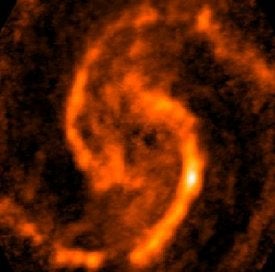Distant spiral galaxies have long been of interest to astronomers seeking to understand our home spiral, the Milky Way. Now, for the first time, astronomers have been able to compare the spiral arms of the Milky Way to M51, its famous neighbor known as the Whirlpool Galaxy.
M51 lies about 31 million light-years away in the constellation Canes Venatici. It can be seen almost face-on from Earth and is a familiar sight to amateur astronomers and a popular image for magazines, books, and posters.
By analyzing the radio emissions from carbon monoxide in the huge gas clouds along M51’s arms, scientists were able to determine the temperature and turbulence of the clouds. Their results, which were presented at the 2004 meeting of the American Astronomical Society (AAS) in Denver, Colorado, support a 1964 theory that “density waves” explain how spiral arms can persist in a galaxy without winding themselves so tightly as to disappear.
Their data indicate that gas on the trailing edge of the spiral arm, which had most recently passed through the density wave, was both warmer and more turbulent than gas in the forward edge of the arm. The results show how the density wave operates on a cloud-to-cloud scale, promoting and preventing star formation in the galactic arms and keeping the arms from collapsing.
Another spiral galaxy, this one even closer to home, has provided clues about star formation in galactic centers. NGC 6946, which lies about 18 million light-years away in the constellation Cepheus, is similar in shape to the Milky Way, but its center houses a prolific stellar nursery, where about three new stars are born every year. This is a stark contrast to the Milky Way’s center, which is dominated by a black hole.
Astronomers have long known that such a high rate of star formation could be sustained only by a huge amount of gas flowing into the stellar nursery. Previous observations have shown that NGC 6946 does contain a lot of gas, but astronomers weren’t sure if the gas clouds strewn about the galaxy could make their way to the galaxy’s center.
Now, a team led by Torsten Böker of the European Space Agency has presented the first evidence that a stream of cold molecular gas extends along the spiral arms all the way to the galaxy’s center. The mass of the gas in the central 300 light-years of NGC 6946 is equal to that of four million suns, providing plenty of fuel for star formation.
These results, also presented at the AAS meeting, are likely to interest scientists who study the dynamics of gas and dust inside galaxies. Scientists now need to determine the mechanisms that make it possible for clumps of gas to leave their orbits and travel to the galactic center.










